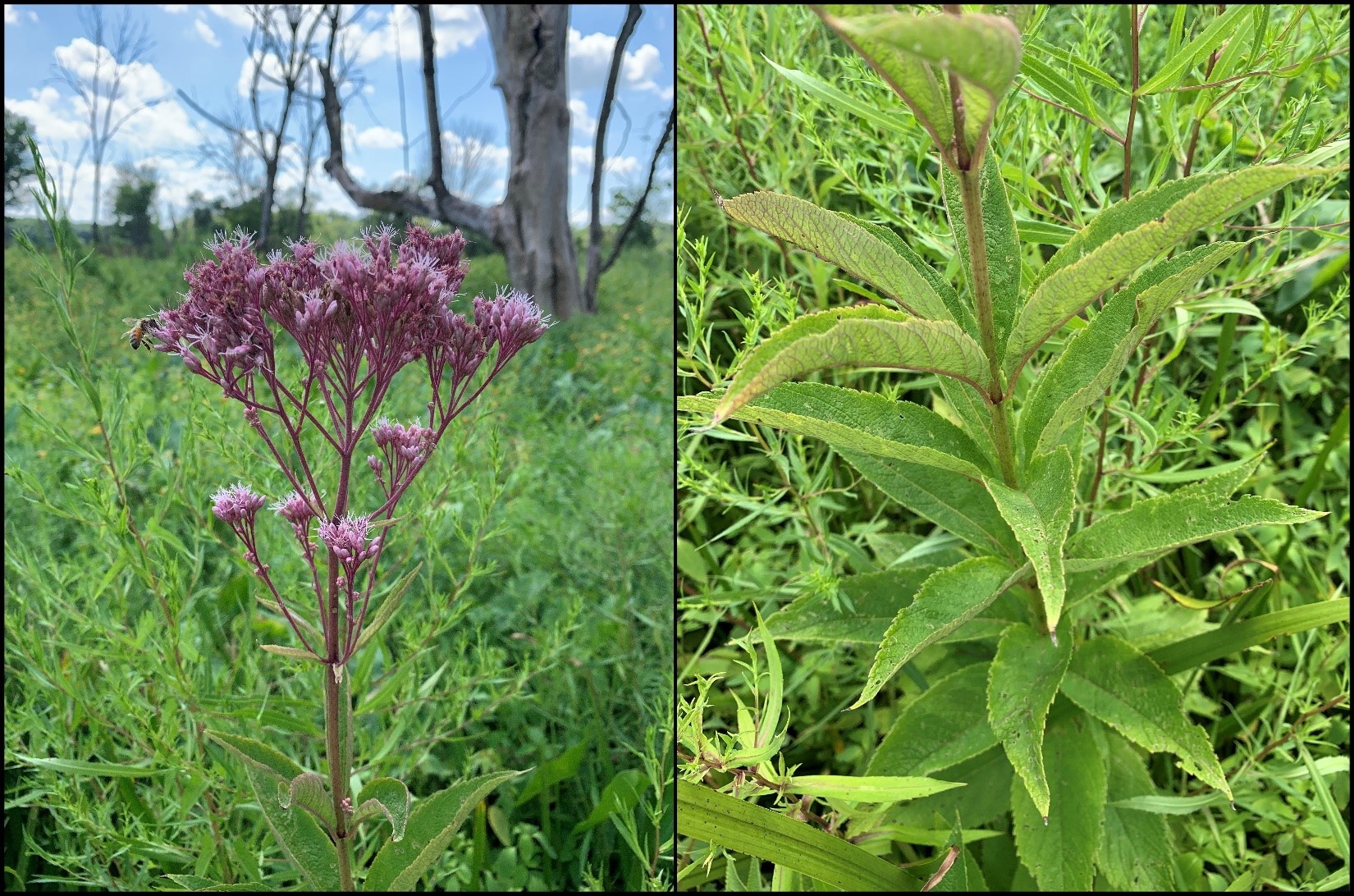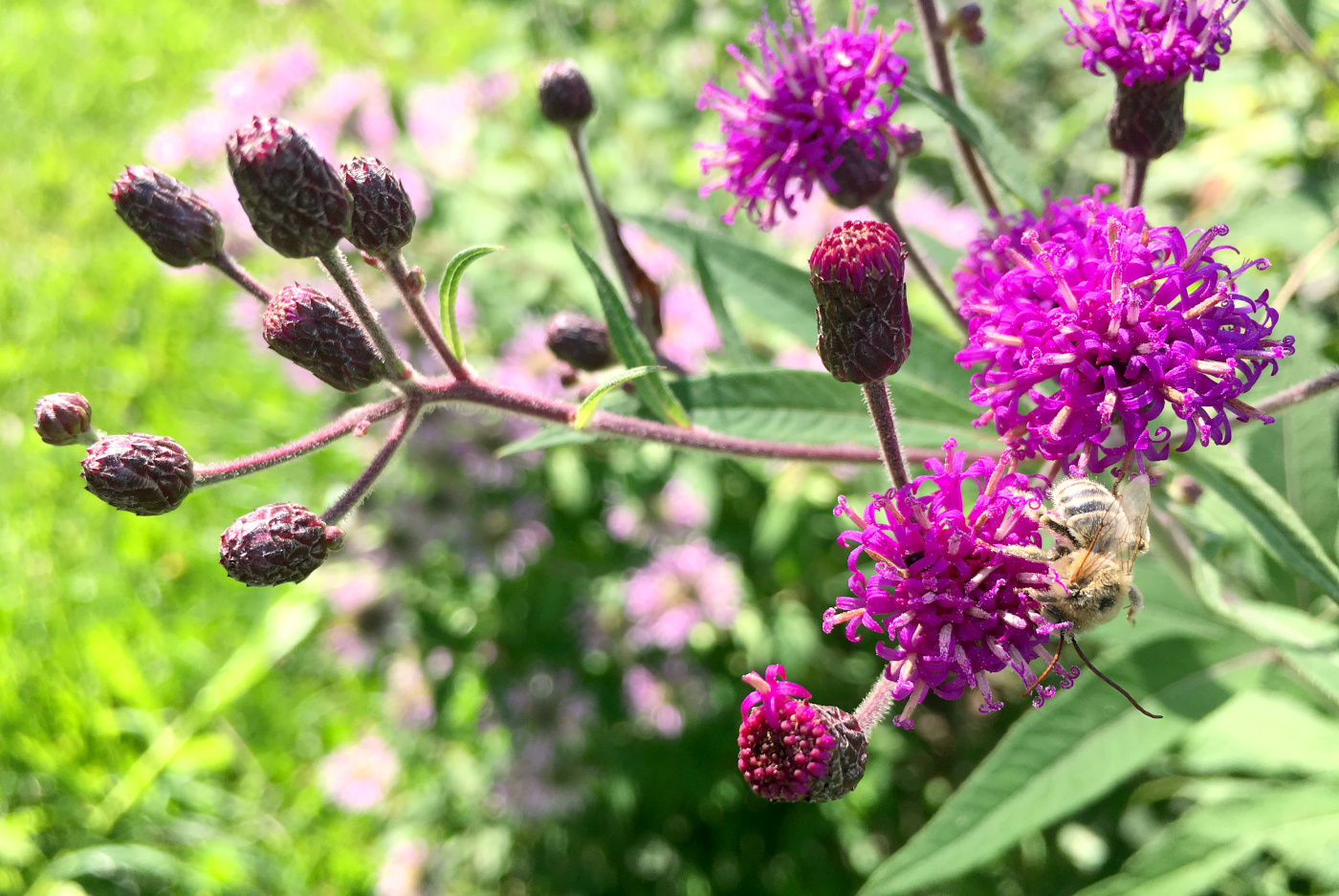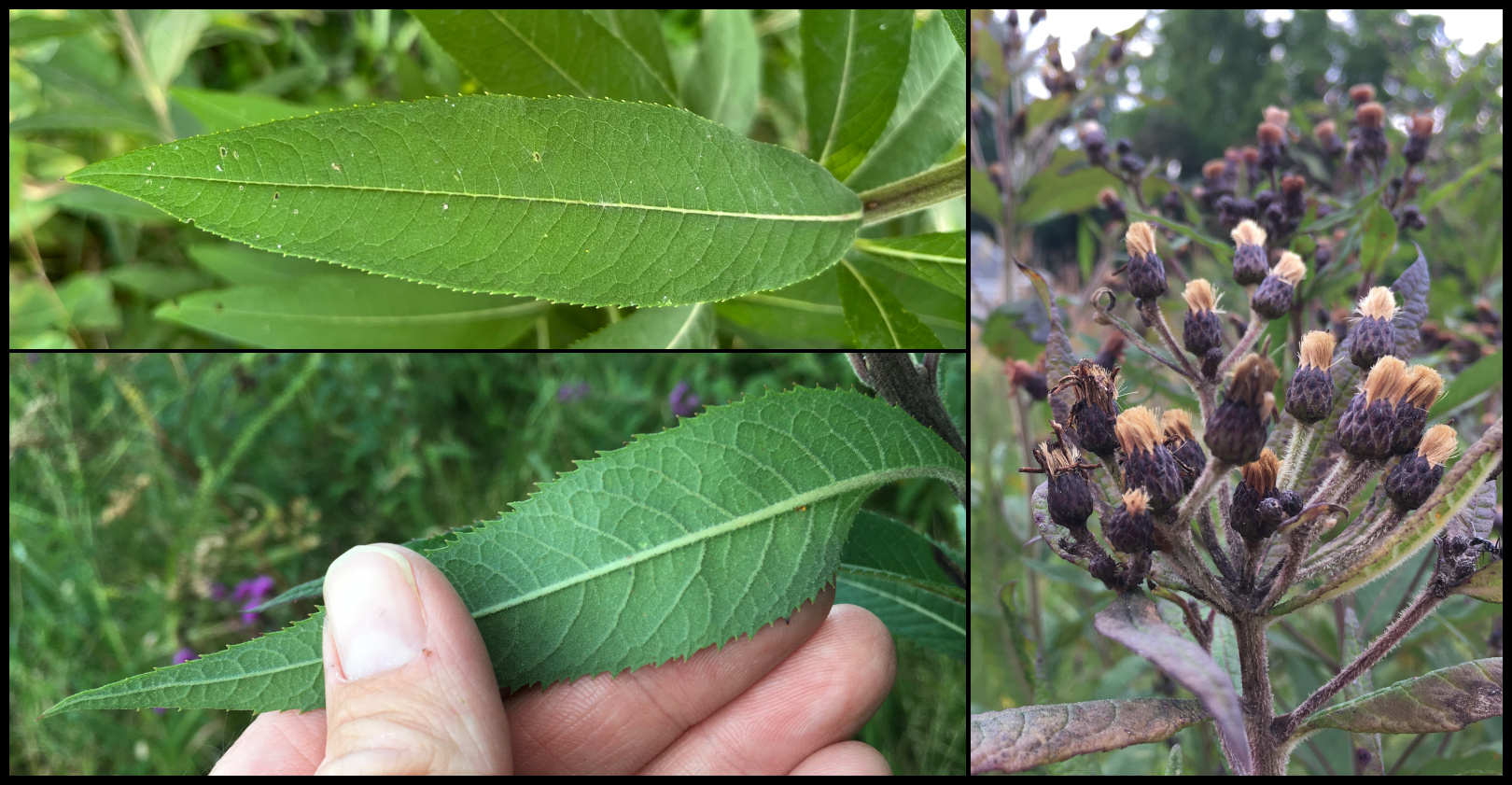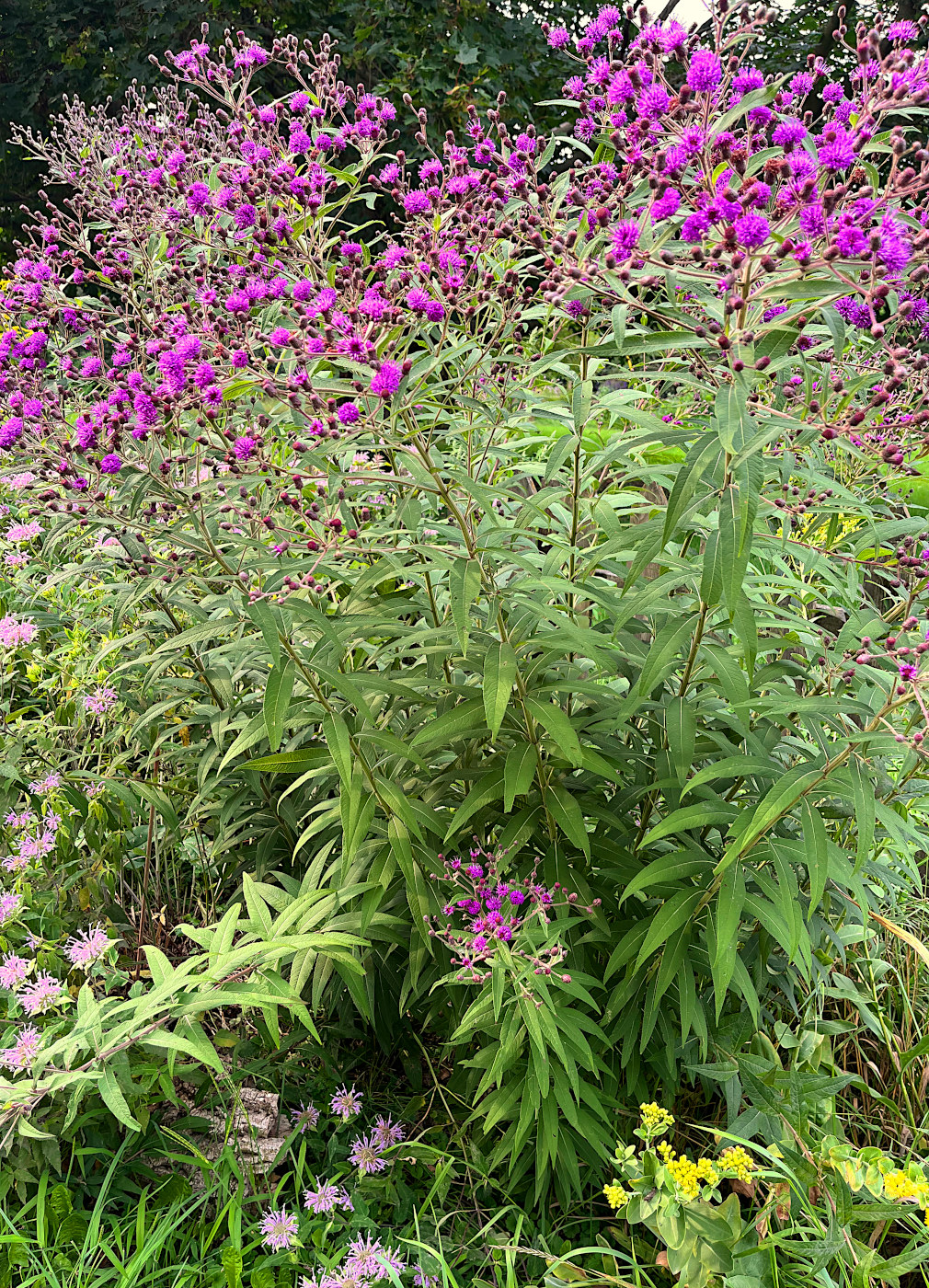Drive-by botany: Joe Pye weed and ironweed
Profiles of common Michigan roadside flora in mid-August 2023.

Authors’ note: Drive-by Botany is a continuing series that highlights flowering plants commonly seen from the road. As a service to new readers, we include the introduction with each article. If you're already familiar with the premise, feel free to skip down to the good stuff.
Has a patch of flowers ever caught your eye as you travelled down the road? It certainly happens to us all the time! As gardeners and naturalists, we're always interested increasing functional diversity in our gardens and landscapes, so we thought it would be fun to consider some of the roadside plants that we see every day. Each article in this series will feature two plant species that are currently blooming and frequently observed from the road. Our goal is to answer two simple questions:
- What are they?
- Would they make good garden plants?
As part of the process, we'll include some biological tidbits and a few useful characteristics for identification. Please note that some of the plants we feature are exotic invasive species; we'll be sure to include recommendations from land management professionals on how to manage them in your landscape.
August 2023 - week 34; 1,923 growing degree days (GDD) base 50, East Lansing, Michigan
Joe Pye weed (Eutrochium maculatum)
Eutrochium maculatum, also known as spotted Joe Pye weed, is a native perennial that is a tall pop of color along the roadside in late summer. This species thrives in wet conditions such as swales or open, moist clearnings. It can also be found in less disturbed sites such as bogs, fens, wet prairies or shore lines. It is attractive to pollinators and oftentimes butterflies, moths and bees can be seen feeding on the nectar from the flower.
Description
Flowers: Pink flower heads are clustered together on a somewhat flat-topped arrangement. Joe Pye weed is a member of the Aster family. You can read more from Michigan State University Extension in this article about the typical composite flower head of asters in the ox-eye daisy profile. Each flower head of Joe Pye weed consists of petal-less disk flowers and lacks ray florets. The stringy structures that one could mistake for the “petals” are actually the styles, which are a part of the flower reproductive system. The style carries pollen to the ovary. Upon close inspection you can see them protruding from the center of each disk flower.
Leaves: Joe Pye weed has whorled leaf arrangement, usually with leaves in groups of four or five (sometimes three and six). The leaves are coarsely toothed and can be up to 9 inches long, usually about 2 inches wide.
Stems: Stems range in color from green to solid purple. Purple spots are a helpful identification feature for Eutrochium maculatum, hence the common name spotted Joe Pye weed.
Seeds/fruit: When seeds mature, they turn brown and develop a tuft of light brown hair. Flower heads appear as a mass of these seeds. These seed are a food source for many bird species.

Distribution: Joe Pye weed is found in almost every Michigan county. It can be found throughout North America from Nova Scotia south to North Carolina and from Nebraska to British Columbia.
Blooming period: Joe Pye weed blooms from mid-summer and into early fall (June to October).
Native status: This species is native to the United States and Michigan.
Garden uses: Joe Pye weed is a great addition to the garden, especially if creating a habitat for birds and pollinators is of interest. It is a nectar source mid-summer into fall, and ripe seeds are a food source for birds moving into winter. Keep in mind that this species does grow tall (up to 6 feet) and thrives in moist and sunny conditions. It tolerates water-logged conditions well and thus is a good option for a shoreline garden. The leaves are favored by insects such as grasshoppers, flea beetles and saw flies, which sometimes leads to some noticeable feeding damage by mid-summer.

Common look-alikes: In Michigan, there are two other Eutrochium species that resemble spotted Joe Pye weed. First is Eutrochium fistulosum, hollow-stemmed Joe Pye weed, which is rare in Michigan. Second is Eutrochium purpureum, green-stemmed Joe Pye weed, which commonly grows in shaded areas and does not have spotted stems. It may have a purple tinge to it, though.
Missouri ironweed (Vernonia missurica)
Synonyms: ironweed
Ironweed is the common name given to a group of plants within the genus Vernonia. Vernonia is known for the vivid purple flowers of many of its member species as well as the propensity for similar species to hybridize. In Michigan, we have two Vernonia species: Missouri ironweed (V. missurica) and giant ironweed (V. gigantea, also known as tall ironweed). Both species are very similar in form and function and readily hybridize in places where their ranges overlap, resulting in specimens with intermediate characteristics. In these situations, differentiating between the two species and their hybrids can quickly become an exercise in frustration. For the casual observer, we feel that simply calling it ironweed (and then moving on with your day) is a perfectly acceptable approach. All descriptions in this profile are of the more common species, V. missurica, unless otherwise noted.

Description
Flowers: Missouri ironweed flower heads are a vivid magenta and easily visible from the road (Photo 4). Each plant produces inflorescent clusters of flower heads, roughly in the form of a corymb, at the apex of branchless stems (learn more about corymbs in our orange daylily profile). Ironweed flower heads consist entirely of 30-60 disc florets that arise from a tear- or egg-shaped base (Photo 5) consisting of numerous ovate-shaped bracts that tightly overlap each other like reptile scales (see our profile of spotted knapweed for a more complete explanation of involucres and bracts).
Leaves: Ironweed leaves are dark green, usually lanceolate (occasionally ovate) and arranged alternately along the stem on short petioles (Photo 5). They can be as long as 7 inches for V. missurica and 9 inches for V. gigantea. Although the leaves of both species have serrated margins and hairs on the underside, a key difference is that the hairs on Missouri ironweed are longer and far more conspicuous (Photo 4) than those of giant ironweed.

Stems/size: According to some sources, ironweed stems are the inspiration for their common name. Stout and tough, Missouri ironweed stems are typically 3-6 feet tall and covered with thin white hairs (Photo 5). Established plants will send up more than one stem from a central crown that, aside from the reddish-brown flowering stalks of the inflorescence, are almost always unbranched (Photo 6).

Seeds/fruit: Missouri ironweed produces achenes, which are a type of dry fruit with a single seed contained within a hardened wall. The achenes are roughly cylindrical with narrow ribs and tufts of brown hair that catch the wind (Photo 5).
Distribution: V. missurica has been recorded in 18 U.S. states from Michigan south to Florida and west to eastern Texas. Although it has been found in at least one New England state, nearly all of the records come from the Midwest and Great Plains. Within Michigan, it is currently documented in 24 counties, all of which are located in the southern half of the Lower Peninsula.
Missouri ironweed naturally prefers moist soils and open areas, but still grows well in slightly drier and shadier locations. As such, it thrives in wet prairies, fens, riverbanks and flood plains, but can also be found in fields, fence rows and roadside ditches.
Blooming period: Although it can vary with seasonal growing conditions, in Michigan, Missouri ironweed typically flowers throughout the month of August.
Native status: This species is native to the United States.
Garden uses: Ironweed is a moderately-tall, full-sun perennial that can be an excellent addition to both wild and formal gardens. It is an especially good choice for rain gardens and lower areas of a property where the soil remains moist for longer periods of time. Although it's rare to find ironweed growing wild in upland areas, it does perform well in gardens with average levels of soil moisture. Removing spent flowerheads before seed set can reduce the number of unwanted seedlings the following year.
Jeremy's gardening tips: Consider pairing with goldenrod (Solidago spp.) and Marsh Blazing Star (Liatris spicata), which tend to bloom at the same time. Not only are they all pollinator favorites (Photo 4), but the purple and yellow flowers compliment each other wonderfully. For added texture, consider native grasses such as Indian grass (Sorghastrum nutans) and Big Bluestem (Andropogon gerardii).
Common look-alikes: Giant ironweed/tall ironweed (V. gigantea), prairie ironweed (V. fasciculata)
Want more Drive-by Botany? Check out some of our other roadside adventures!
- Yellow coneflower and wild bergamot
- Chicory and common mullein
- Purple loosestrife and spotted knapweed
Questions? Feel free to contact Jeremy Jubenville, Barslund Judd, or Lindsey Kerr with the MSU Extension landscape team.
Thank you to Tyler Bassett from the Michigan Natural Features Inventory for his review of this article.
Resources:
- Michigan Flora (2001) – E. Voss
- Flora of North America Editorial Committee, eds. 1993+. Flora of North America North of Mexico. Vol 21. 2006.
- USDA PLANTS Database – Vernonia missurica (plants.usda.gov)
- USDA PLANTS Database – Vernonia gigantea (plants.usda.gov)



 Print
Print Email
Email










